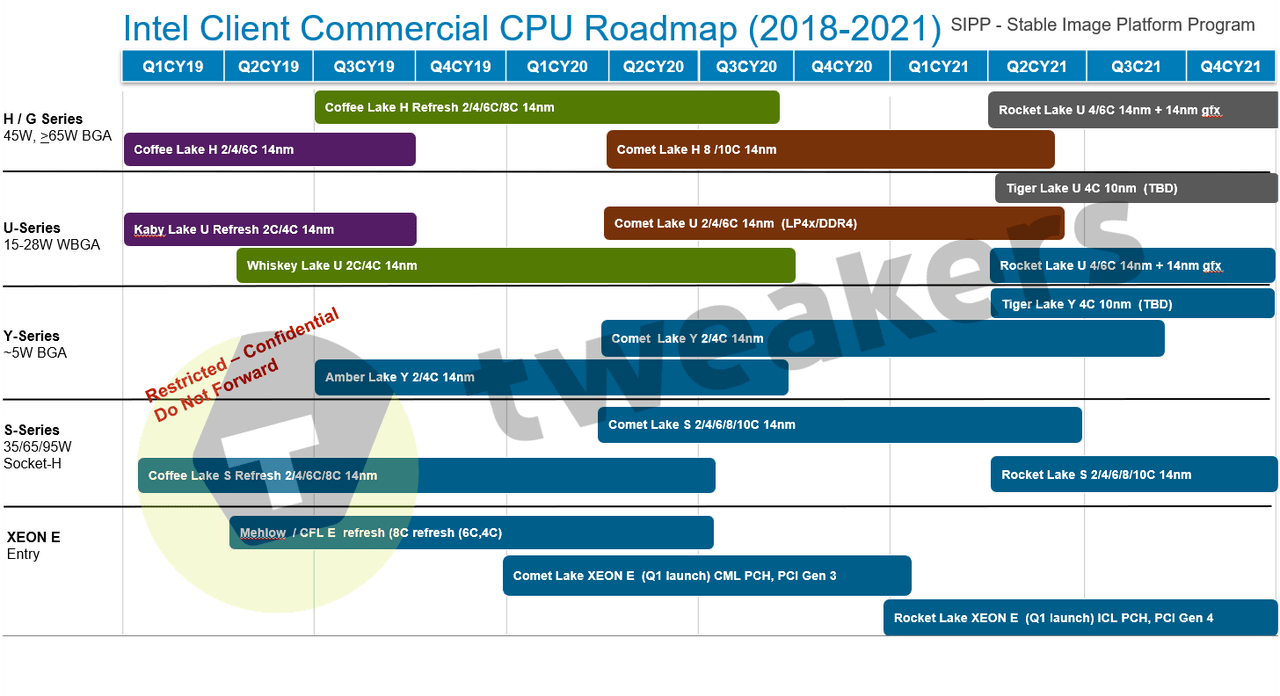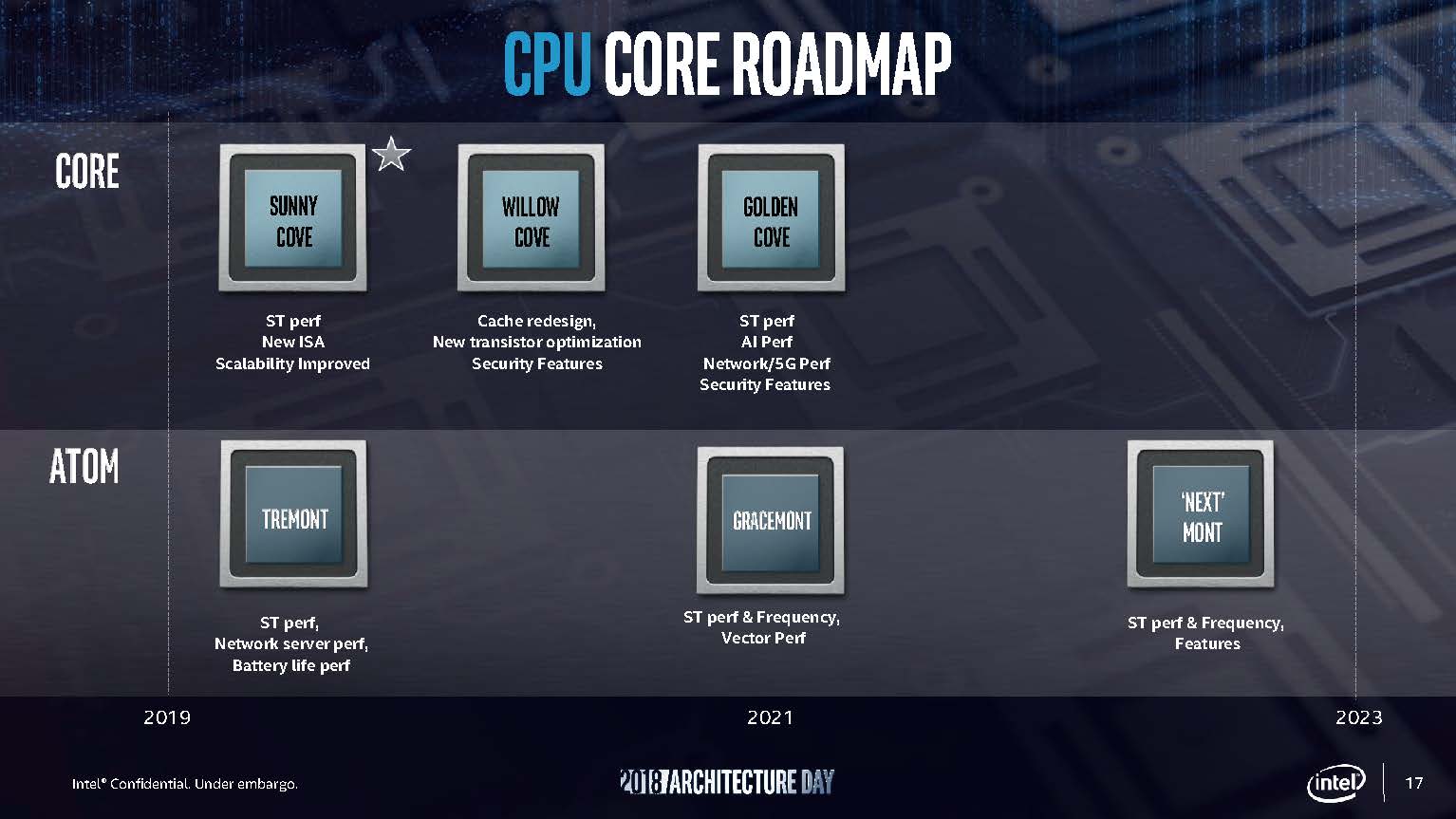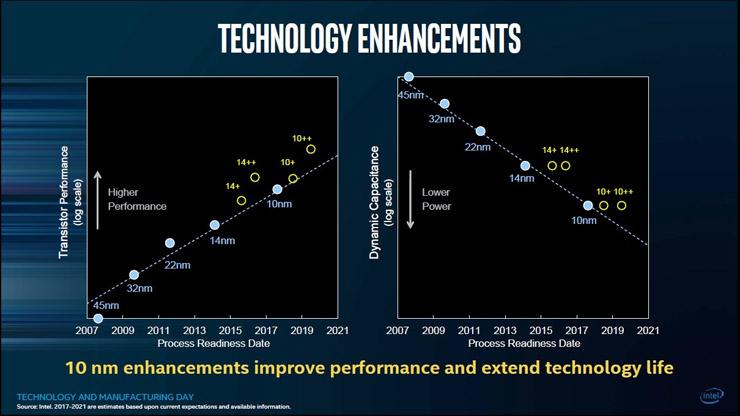Major Intel Roadmap Leak: Ice Lake in Q2, Tiger Lake And 14nm Rocket Lake In 2020
A purported new Intel client roadmap has leaked today, showing the company’s plans through 2020 and 2021 across the client product stack, with a particular focus on mobile products. The mobile roadmap also unveils the first concrete plans for Intel's 10nm GPUs along with news of the Comet Lake launch this year.
According to the leaked images, the company has yet another 14nm product line called Rocket Lake planned for 2020 alongside 10nm Tiger Lake, although interestingly this Rocket Lake family will contain 10nm or 14nm graphics chiplets. Further, the roadmap gives clearer information about the launch of the upcoming Comet Lake, the “limited” Ice Lake launch, along with Lakefield and 10nm Skyhawk Lake on the Atom side in 2020.
Before diving further, the two roadmaps were allegedly contained in a large internal Dell presentation, lending some credibility. That presentation was sent to Dutch tech site Tweakers by an anonymous tipster. The Dell presentation is from 2019, but it not known when precisely Intel created the two roadmaps that were put in that presentation, and we caution that these roadmaps are known to change frequently.
The Mobile Roadmap On 10nm: Lakefield and Ice Lake in Q2, Tiger Lake Next Year
The left edge of the boxes most likely correspond to the planned Intel market launches. The client mobile roadmap covers all 45W and below series, and also includes the G-series that was introduced last year with Kaby Lake-G with Vega graphics. It also covers the rest of Intel's plans through the end of 2020.
The roadmap confirms some information we already know, such as yesterday’s launch of the 9th-Gen Coffee Lake-H Refresh with eight cores, but also Ice Lake (both U- and Y-series) and Lakefield (as a reminder, Lakefield contains one Ice Lake Sunny Cove core and four Atom Tremont cores). However, those are now given release dates in the current quarter. Lakefield is also disclosed to have a TDP of 3-5W. That's even below the Atom series, and close to the thermal design power (TPD) of a phone chip.
So far Intel has publicly maintained a release schedule of "2019 holidays" for 10nm products to hit the shelves. However, since the beginning of the year, leaks have suggested a June launch was possible. This roadmap says that Ice Lake and Lakefield are indeed planned for the second quarter, so it is likely we will hear more at Computex.
But make no mistake: Intel says it created Lakefield for one specific customer, and the Ice Lake-U entry conspicuously says “limited,” suggesting there will not be all that many laptops with Ice Lake released. Intel is also planning a Lakefield refresh for 2020.
Get Tom's Hardware's best news and in-depth reviews, straight to your inbox.
This earlier schedule for Ice Lake also changes the expectations for Tiger Lake, the second-gen 10nm family, which is most likely based on the Willow Cove CPU cores and the Gen12 Xe graphics architecture. According to the roadmap, Tiger Lake is now set for a launch in the second quarter of next year. But it seems Tiger Lake, just like Ice Lake, will be constrained to the low-power Y- and U-series, with the U-series further being constrained to four cores instead of the six-core Comet (and Rocket) Lake chips, as we'll discuss shortly.
Extrapolating further out, if Intel keeps this yearly schedule, it is likely that Alder Lake with Golden Cove cores will launch in early 2021.
Comet Lake: Six Cores For The Masses
The roadmap also reveals that Intel is planning to release the mobile variants of the 14nm Comet Lake family in the second half of the year, with Comet Lake-U first, followed by Comet Lake-H towards the end of the year, and the low power Comet Lake-Y early next year.
As Comet Lake will be yet another refresh of the Skylake architecture, its main selling point seems to be an increase in core count by two, as the popular 15W U-series will be available with up to six cores while the beefier H-series jumps to 10 cores.
Rocket Lake: 10nm graphics in Q3’20
Somewhat more interesting, and the first truly new information, is the addition of Rocket Lake as a new codename for yet another 14nm product family. In both roadmaps, Rocket Lake (not to be confused with Rocket League) shows no changes to the existing lineup's core count.
However, most interesting about this family is that the roadmap says it will contain 10nm graphics and is slated to launch around the middle of 2020. This suggests that while Intel will continue to build the CPU on 14nm, Rocket Lake will contain a graphics chiplet with Intel’s 10nm graphics–in all likelihood based on the Xe architecture.
Hence this might give an upper bound of when Intel plans to release its first discrete graphics cards in 2020. Whether this 10nm graphics chiplet will be connected to the CPU as a regular MCP (multi-chip package) as in Kaby Lake-G, or via Intel’s 2.5D EMIB packaging technology, is not known. The other roadmap suggests there will also be a 14nm graphics chiplet, which is interesting as Intel has not talked about releasing discrete 14nm graphics.
In any case, the big takeaway is that Comet Lake and Rocket Lake will leave little room for high-volume 10nm products in 2020, giving a bleak picture of the size of the 2020 10nm ramp, despite Intel having done its best to show a wide range of 10nm products from client to data center. That includes Ice Lake-SP with presumably quite a large die that Intel says will launch in the middle of next year.
Atom: Elkhart Lake and Skyhawk Lake on 10nm
When it comes to Atom, Intel is purportedly planning a Gemini Lake refresh later this quarter. Gemini Lake is currently based on Goldmont Plus cores. In the second half of 2020, Atom will transition to 10nm.
The Elkhart Lake codename had already leaked, and the leaked roadmap suggests this is a lower-power product meant for the internet of things. Skyhawk Lake is a new codename and should be the true successor of Gemini Lake. Since Intel put a 2021 date on Gracemont, this will probably be based on the Tremont architecture.
Desktop: Not So Clear
The second roadmap contains more information about Intel's S-Series desktop roadmap. The roadmap confirms the existence of the 10-core Comet Lake-S, slated for early next year. We discussed this previously, but in short, Comet Lake is still based on the Skylake microarchitecture and 14nm.
Rocket Lake-S purportedly arrives in 2021, still on 14nm with 10 cores. It seems that Intel is not planning to follow AMD in the core wars, as the roadmap tallies Rocket Lake at 10 cores, while AMD has recently shown a Zen 2 desktop CPU with room for two eight-core chiplets on the package, which could foreshadow the arrival of 16-core Ryzen models.
While nothing is known about Rocket Lake, one tantalizing possibility to ease the pain of yet another 14nm refresh is that Rocket Lake could be one of the "Coves" Intel disclosed at Architecture Day in December. Intel talked about how it planned to decouple new architectures from specific process nodes, leaving open the possibility that Intel simply chose to use the 14nm process for Rocket Lake, as it knows that 14nm can reach its frequency targets and has an extremely mature yield rate, while neither might be the case for 10nm.
Moving on to the worrisome part of this roadmap, assuming a yearly release cadence, this would seem to remove the possibility of Intel releasing a 10nm line of desktop CPUs until at least early 2022. That's three long years from now.
Now, Intel shying away from releasing 10nm desktop products (compared to the upcoming Ice Lake products) probably has a lot to do with the fact that desktop CPUs require very high frequency targets, with 14nm++ products reaching single core turbo speeds of up to 5GHz. That's a high bar to break for a new process, even if this means leaving the desktop products without the power consumption benefits of 10nm.
Intel has previously shown a slide that compares the theoretical switching speed of a single transistor on the various process nodes, showing that 14nm++ has about the same capabilities as 10nm+ in terms of frequency targets (at least in principle and leaving aside any architectural influences). However, at Architecture Day, Intel did confirm that there will be 10nm desktop CPUs at some point, and the company has previously said it designed the 10nm cell libraries for frequencies higher than 5GHz.
It stands to reason, then, that Intel is holding 10nm on the desktop back until 10nm++ with Golden Cove, but that still leaves the problem that both are expected to be ready in 2021, not 2022 as this roadmap suggests.
So, to give a few important words of caution about this roadmap, though, is this roadmap is related to Intel’s SIPP, or Stable Image Platform Program. This is a quality insurance program from Intel targeted at the enterprise, readily leaving open the possibility of hardware outside the SIPP program being released earlier.
For instance, the Xeon-E parts in this roadmap are released one quarter before the Core series, which is not what Intel has typically done in the past with its “regular” product launches. Indeed, a comparison of the dates for Comet Lake and Rocket Lake on both roadmaps confirms that this roadmap likely does not give the most representative picture of when these parts will be available for consumers.
One last piece of information Rocket Lake: it will make use of the Ice Lake PCH with PCIe Gen 4, as opposed to the Comet Lake PCH with PCIe Gen 3.
Conclusions
The roadmaps leaked today might give a closer look at Intel’s plans in the coming few years, with Rocket Lake being the primary addition to our picture of Intel’s plans for the foreseeable future. On the mobile side, Intel will follow the easy path with Comet Lake this year, adding two more Skylake cores across the board, although its release schedule is later than we would have liked since Coffee Lake launched in early 2018 (Intel did a mid-cycle refresh with Whiskey Lake, adding some hardware security mitigations). This, however, will leave little room for Ice Lake to launch in high volume, instead being relegated to a “limited” product.
The extent to which the same happens with Rocket Lake and Tiger Lake in 2021 is not clear yet, but the absence of a six-core SKU for Tiger Lake-U could say something about which family Intel views as the more important.
There is a little bit room for hope, as we can’t rule out yet the possibility of Rocket Lake containing the Willow Cove cores, but built on 14nm. In any case, Rocket Lake seems to contain the Xe graphics as a 10nm chiplet, suggesting that the discrete Xe graphics cards could launch well before the end of 2020. Tiger Lake is likely going to contain Xe graphics as well. On the other hand, Rocket Lake shows no signs of further increasing core counts.
The one positive with Ice Lake and Tiger Lake is that they will show up earlier than most would have believed after last year’s round of 10nm delays. For Atom, Skyhawk Lake is the new addition to look forward to in 2020.
Moving to the desktop side, we are not willing to speak with the same confidence as the mobile roadmap because the desktop information is from a commercial SIPP roadmap. That doesn't really reflect the earliest end-user availability for consumers.
While that roadmap does not show any desktop parts on 10nm through 2021, a comparison of both roadmaps shows that the difference in release schedules for consumer and commercial in Comet Lake and Rocket Lake is about nine months later for commercial.
Further evidence that Intel would like to leave those parts on an older cadence comes from the supposed addition of a 14nm graphics chiplet with commercial Rocket Lake, whereas the mobile roadmap has a 10nm graphics chiplet.
One thought here is that last year in the midst of the shortage news, Intel put out a press release stressing their investments in 14nm capacity, making it likely that Intel wants to use every opportunity to keep moving volume through its high-yielding 14nm fabs, leaving parts on 14nm where leading-edge nodes are not required, which certainly is the case for SIPP CPUs.
Intel has already shown a few bigger 10nm dies like Ice Lake-SP, and there are no material signs that 10nm can’t hit high frequencies, making us doubt that Intel really wants to cede AMD the opportunity to have 7nm on the desktop for a few years while Intel is stuck on 14nm.




